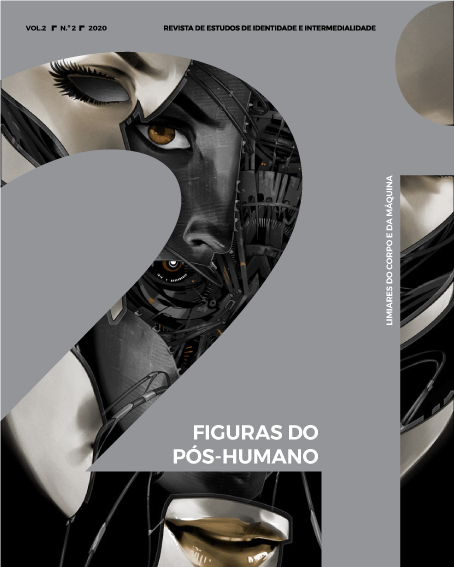The posthuman inhabiting between inversion and eversion in “Watch_Dogs” video games
DOI:
https://doi.org/10.21814/2i.2663Keywords:
cyberpunk; posthuman; smart city; transversion; video game.Abstract
This paper focuses on the posthuman inhabiting depicted in cyberpunk video games in the WATCH_DOGS franchise. After a redefinition of the posthuman in ontogeographical terms, specificities of the posthuman inhabiting will be describe as “transversion”, a phenomenon seen as the result of a dynamic movement between inversion (introjection of human milieus inside physical boundaries of the body through techniques) and eversion (projection of the body in the milieu through techniques). Subsequently, an analysis will be provided on the way WATCH_DOGS depicts transversion in the context of smart cities understood as posthuman cities.
Downloads
References
Aubry, P., Berque, A., Le Dantec, J.-P., Luginbühl, Y., Donadieu, P., et Laffage, A. (2006). Mouvance II, soixante-dix mots pour le paysage. Éditions de la Villette.
Batty, M. (2013). Big Data, Smart Cities and City Planning. Dialogues in Human Geography, 3(3), 274-279.
Benjamin, W. (1982). Charles Baudelaire : un poète lyrique à l’apogée du capitalisme. Payot.
Berque, A. (1990). Médiance, de milieux en paysages. Belin/Reclus.
Berque, A. (2000). Écoumène : Introduction à l´étude des milieux humains. Belin.
Berque, A. (2011). Préface. Dans Fûdo : Le milieu humain, Paris (p. 11-29). CNRS.
Boulter, J. (2015). Parables of the Posthuman: Digital Realities, Gaming, and the Player Experience. Inscribe Digital.
Breton, P. (1992). L'utopie de la communication. La Découverte.
Bril, M. (2016). Un jour nous vivrons dans des villes intelligentes, Mondes sociaux. https://sms.hypotheses.org/8615
Clark, A. (2003). Natural-Born Cyborgs: Minds, Technologies, and the Future of Human Intelligence, Oxford University Press.
Clarke, R. (1988). Information Technology and Dataveillance. ACM, 31(5), 498-512. https://dl.acm.org/doi/10.1145/42411.42413
Doxiadis, K. A. (1969). The city (II): Ecumenopolis, World-City of Tomorrow. Impact of Science on Society, 19(2), 179-193.
Duret, C. (2019). Le goût pour le Moyen Âge dans les fictions post-catastrophiques contemporaines : Une lecture mésocritique [thèse de doctorat, Université de Sherbrooke]. Savoirs UdeS. https://savoirs.usherbrooke.ca/handle/11143/16057
Dyson, F. (1979). Time Without End: Physics and Biology in an Open Universe, Reviews of Modern Physics, 51, 447-460.
Frautschi, S. (1982). Entropy in an Expanding Universe. Science, 217(4560), 593-599.
Haggerty, K. D., et Ericson, R. V. (2000). The Surveillant Assemblage. British Journal of Sociology, 51(4), 605-622.
Haney, W. S. (2006). Cyberculture, Cyborgs and Science Fiction: Consciousness and the Posthuman, Rodopi.
Hayles, N. K. (1999). How We Became Posthuman: Virtual Bodies in Cybernetics, Literature, and Informatics. Chicago University Press.
Jameson, F. (1991). Postmodernism, or, the Cultural Logic of Late Capitalism, Duke University Press.
Le Breton, D. (1999). L’adieu au corps, Métailié.
Lestel, D. (2014). Des enjeux de la tentation posthumaine. Dans B. Munier (dir.), Technocorps (p. 145-170). Éditions François Bourin.
Loth, F. (2013). Le corps et l'esprit : Essai sur la causalité mentale. Vrin.
McHale, B. (2010). Towards a Poetics of Cyberpunk. Dans G. J. Murphy et S. Vint (dir.), Beyond Cyberpunk: New Critical Perspectives (p. 3-28). Routledge.
Mongin, O. (2013). La ville des flux : L’envers et l’endroit de la mondialisation urbaine. Fayard.
Munier, B. (2014). Introduction. Dans B. Munier (dir.), Technocorps (p. 7-19). Éditions François Bourin.
Picon, A. (1998). La Ville territoire des cyborgs. Les Éditions de l'Imprimeur.
Picon, A. (2013). Smart cities : Théorie et critique d’un idéal auto-réalisateur. Éditions B2.
Picon, A. (2016). L’avènement de la ville intelligente, Sociétés, 132, 9-24.
Ricœur, P. (1986). Du texte à l’action : Essais d’herméneutique II. Seuil.
Sadin, É. (2009). Surveillance globale : Enquête sur les nouvelles formes de contrôle. Climats Éditions.
Watsuji, T. (2011). Fûdo : Le milieu humain. CNRS.
Wolfe, C. (2009). What is Posthumanism ? University of Minnesota Press.
Références audiovisuelles
Ubisoft Montréal. (2014). WATCH_DOGS [Xbox ONE], Ubisoft.
Ubisoft Montréal. (2016). WATCH_DOGS 2 [Xbox ONE], Ubisoft.
Published
Versions
- 2020-12-03 (2)
- 2021-05-04 (1)
How to Cite
Issue
Section
License
Copyright (c) 2020 Journal 2i: Identity and Intermediality Studies

This work is licensed under a Creative Commons Attribution-NonCommercial 4.0 International License.


.jpg)










